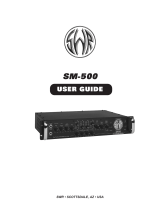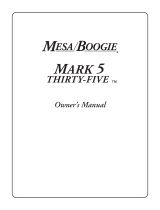Page is loading ...

Nemesis NSP Series
Owners Manual
Bass Guitar Speaker Enclosures
For All NSP Speakers
Covering Models
NSP2104(E), NSP2108(8), NSP4104(E),
NSP4108(E), NSP115(E), NSP212(E),
NSP810(E)
© 3/5/2005 U. S. Music Corp.

Nemesis Series Bass Enclosure NSP Products
Owner’s Manual 3/15/05
Thank you for your purchase of a Nemesis Series loudspeaker enclosure.
This cabinet has been designed and constructed to give you years of trouble
free service. The unique composite construction of your NSP Series speaker
enclosure is made from recycled cellulose fiber, which is both stronger and
lighter than traditional plywood enclosures, as well as being environmentally
friendly.
Please take the time to review this manual and to send in your warranty
registration card.
CAUTION!
Your ears are your most important piece of equipment. Unfortunately, they
cannot be replaced as easily as your other gear. Please take the following
warning seriously.
This product, when used in combination with amplification and/or additional
loudspeakers may be capable of producing sound levels that could cause
permanent hearing loss. DO NOT operate at high volume levels or at a
level that is uncomfortable. If you experience any discomfort or ringing in
the ears or suspect hearing loss, you should consult an audiologist.
BASIC CONNECTIONS AND OPERATION
There are three speaker connections on the connection panel: two standard
1/4 inch jacks and one NL4 connector. These connections are all wired
together in parallel. This means that any of the connections can accept the
input from your amplifier and that the remaining two connections can be
used to connect to additional speaker cabinets if desired. NEVER
CONNECT TWO AMPLIFIERS TO ONE CABINET.
The level of the tweeter is set to flat in the enclosure. It is not user
adjustable.
You should make all your connections before turning your amplifier on.
Standard 1/4 inch plugs are less than ideal in their ability to transfer the
signal from your amplifier. This is due to the limited amount of actual

contact area in these connections. For best performance, we recommend
using NL4 style speaker connectors. We also recommend using high quality
speaker cables of at least 16 gauge minimum (smaller numbers indicate
larger cable). Do not use shielded instrument cable for speaker connections,
unless you want to cause serious damage to your amplifier.
The rear (inside) of the connection panel also houses the crossover and
tweeter protection system. This system uses an aircraft grade light bulb in a
circuit that is designed to absorb current, that is in excess of the power
handling ability of the tweeter. In cases of very high levels of high
frequency information (such as feedback from facing the cabinet with your
instrument turned up), the bulb can glow brightly enough to illuminate the
interior of the cabinet and shine through the speaker surrounds. While this is
a rather dramatic display of the protection circuit, it should not be done
intentionally (find a better way to impress the drummer), as excess amounts
of current will cause the bulb to act like a fuse and fail. This requires
replacement before the tweeter will function. Replacement bulbs are
available from our factory. In an emergency, an automobile dome light bulb
can be used to restore the system. To replace the bulb, simply remove the
screws that secure the connection plate to the back of the cabinet. Gently
pull the plate out and replace the bulb in its connection clips.
BREAK-IN PERIOD
We recommend that you use your Nemesis cabinet at low to moderate
volume levels for approximately ten hours before using it in a high volume
situation. This will allow the voice coils to “seat” themselves and the
speaker suspensions to begin work in. It will actually take about 24 to 50
hours of total playing time to fully break in your speaker system.
CONNECTIONS WITH ADDITIONAL CABINETS
It is important to keep two issues in mind when connecting your Nemesis
cabinet with other cabinets, phase relationships and impedance. Proper
parallel connections require the positive and negative speaker terminals to
maintain their relationships throughout the system. This means that the
positive connection (tip on 1/4 inch plugs; the red binding post) on one
cabinet must connect to the positive connection on additional cabinets. The
negative connections should be made in a similar manner. Unless you have
defective cables, 1/4 inch connections make incorrect connections highly
unlikely. If you are using NL4 plugs to connect there should be no problem
with phase relationships. If you wish to connect multiple cabinets in series,

you will need to use special single wire cables with individual banana plugs,
attaching them to the cabinets as shown below (you can purchase 1/4 inch
banana adapters for this purpose, if necessary.)
Parallel Connection Series Connection
`
Impedance is a measure of the load your speaker system places on your
amplifier. Too great a load (indicated by a lower impedance figure) can
damage your amplifier. Too small a load (indicated by a higher impedance
figure) can fail to draw adequate power from your amplifier. Please consult
your amplifier’s manufacturer literature for impedance recommendations.
When you connect speakers in parallel, the load increases as shown below:
Parallel speaker configurations Total system impedance
Two 8 ohm cabinets
4 ohms
One 8 ohm cabinet and one 4 ohm cabinet
2.6 ohms
Two 4 ohm cabinets
2 ohms
Three 8 ohm cabinets
2.6 ohms
Two 8 ohm cabinets and one 4 ohm cabinet
2 ohms
One 8 ohm cabinet and two 4 ohm cabinets
1.6 ohms
When you connect speakers in series, the load decreases as shown below:
Series speaker configurations Total system impedance
Two 8 ohm cabinets
16 ohms
One 8 ohm cabinet and one 4 ohm cabinet
12 ohms
Two 4 ohm cabinets
8 ohms
Three 8 ohm cabinets
24 ohms
Two 8 ohm cabinets and one 4 ohm cabinet
20 ohms
One 8 ohm cabinet and two 4 ohm cabinets
16 ohms
Amp + -
Amp + -
Spkr. 1
+ -
Spkr. 1
+ -
Spkr.
2--
+ -
Spkr. 2
+ -

As you can see, problems tend to arise when using more than two cabinets.
In these cases, a combination of parallel and series wiring may be helpful.
Speaker configurations Total system impedance
Two 4 ohm cabinets in series plus one 8
ohm cabinet in parallel.
4 ohms
Two 8 ohm cabinets in parallel plus one 4
ohm cabinet in series
8 ohms
POWER HANDLING
Your system can be damaged by too much or too little amplifier power.
While the amount of amplifier power reflects the potential for damage, how
that power is used (your playing style) is the critical variable. Too small an
amplifier, when pushed to its limit too often, can generate excessive
clipping. This can generate a signal with enough high extra frequency
distortion to eventually overheat and burn up a voice coil. Too large an
amplifier, when pushed near its limit, can push the speaker beyond its
physical limits. Your playing style determines how much headroom (reserve
amplifier power needed to handle short bursts of sound) you will need. Slap
style playing is particularly demanding, as short bursts of low frequency
information require a great deal of power to be produced accurately without
distortion. You should choose an amplifier that delivers adequate power for
your playing style without frequent clipping, and without exceeding the
cabinet’s power handling maximum during normal usage. It is ok to have
extra power for added headroom; just be careful to use it for that purpose.
Also, keep in mind that simply adding amplifier power will not necessarily
increase your volume significantly. The addition of more speakers will
usually have more impact on your overall volume level and improve your
overall presence and tone.
CABINET PLACEMENT
The placement of your cabinet can also have an impact on the amount of
bass it produces. Placing the unit on the floor increases the amount of bass
you get by an additional +3dB . With each additional wall surface placement
you get another 3dB increase. This is due to the reinforcement of bass
frequencies by the adjacent surfaces. The absence of reinforcing surfaces is
the reason why outside settings are so problematic for bass amplification. A
system that may be perfectly adequate in a fairly large club can be rather

disappointing on an outdoor stage. If you have plans to perform in such a
setting and are not confident that the PA system can provide you with
sufficient reinforcement (both out front and via monitors), you should
consider using additional equipment to support your own sound.
MAINTENANCE
Your speaker system is designed to be trouble free and to require very little
maintenance. You should remember that the weakest links in most systems
are the solderless connection points where your plugs and jacks come
together. These connections are quite vulnerable to contamination, and or
corrosion. Your input jacks, as well as your speaker cable plugs, should be
periodically cleaned using a cotton swab with a solvent such as denatured
alcohol. On cabinets equipped with casters, you should check to make sure
that the screws that hold the caster sockets in place are tight.
CLIMATE AND TRANSPORTATION
Routine temperature extremes (such as cold garages) will not harm your
Eden cabinet. However, you should allow the system to adjust to room
temperature before playing it at loud volumes. If your cabinet is going to be
bounced around severely during transportation, it is best to avoid loading it
with the speaker cones facing down. This puts added stress on the screws
that secure the speakers in the cabinet.
We hope you enjoy your Nemesis NSP Series Bass Enclosure.
All Nemesis/Eden products have a two year warranty.
Please feel free to contact us if we can assist you in any way.
Ask for customer service at 1-800-877-6863
or email: [email protected]
Eden Division of US Music Corp.
444 East Courtland
Mundelein, IL 60060
For more information visit: www.eden-electronics.com
/


